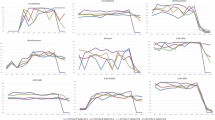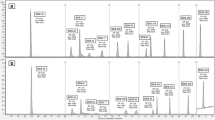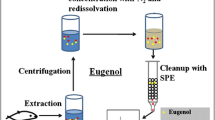Abstract
A new method for rapid determination of 73 target organic environmental contaminants including 18 polychlorinated biphenyls, 16 organochlorinated pesticides, 14 brominated flame retardants and 25 polycyclic aromatic hydrocarbons in fish and fish feed using gas chromatography coupled with triple quadrupole tandem mass spectrometry (GC–MS/MS) was developed and validated. GC–MS/MS in electron ionization mode was shown to be a powerful tool for the (ultra)trace analysis of multiclass environmental contaminants in complex matrices, providing measurements with high selectivity and sensitivity. Another positive aspect characterizing the newly developed method is a substantial simplification of the sample preparation, which was achieved by an ethyl acetate QuEChERS (quick, easy, cheap, effective, rugged and safe) based extraction followed by silica minicolumn clean-up. With use of this sample preparation approach the sample laboratory throughput was increased not only because six samples may be prepared in approximately 1 h, but also because all the above-mentioned groups of contaminants can be determined in a single GC–MS/MS run. Under the optimized conditions, the recoveries of all target analytes in both matrices were within the range from 70 to 120 % and the repeatabilities were 20 % or less. The method quantification limits were in the range from 0.005 to 1 μg kg–1 and from 0.05 to 10 μg kg–1 for fish muscle tissue and fish feed, respectively. The developed method was successfully applied to the determination of halogenated persistent organic pollutants and polycyclic aromatic hydrocarbons in fish and fish feed samples.


Similar content being viewed by others
References
EFSA (2005) Opinion of the Scientific Panel on Contaminants in the Food Chain on a Request from the European Parliament Related to the Safety Assessment of Wild and Farmed Fish. EFSA J 236:1–118
Nácher-Mestre J, Serrano R, Hernández F, Benedito-Palos L, Pérez-Sánchez (2010) Gas chromatography-mass spectrometric determination of polybrominated diphenyl ethers in complex fatty matrices from aquaculture activities. Anal Chim Acta 664:190–198
Nardelli V, dell’Oro D, Palermo C, Centonze D (2010) Multi-residue method for the determination of organochlorine pesticides in fish feed based on cleanup approach followed by gas chromatography-triple quadrupole tandem mass spectrometry. J Chromatogr A 1217:4996–5003
Sánchez-Avila J, Fernandez-Sanjuan M, Vicente J, Lacorte S (2011) Development of multi-residue method for the determination of organic micropollutants in water, sediment and mussels using gas chromatography-tandem mass spectrometry. J Chromatogr A 1218:6799–6811
Sun H, Ge X, Lv Y, Wang A (2012) Application of accelerated solvent extraction in the analysis of organic contaminants, bioactive and nutritional compounds in food and feed. J Chromatogr A 1237:1–23
Sapozhnikova Y, Lehotay SJ (2013) Multi-class, multi-residue analysis of pesticides, polychlorinated biphenyls, polycyclic aromatic hydrocarbons, polybrominated diphenyl ethers and novel flame retardants in fish using fast, low-pressure gas chromatography-tandem mass spectrometry. Anal Chim Acta 758:80–92
Commission regulation (EU) No 1259/2011 of 2 December 2011 amending Regulation No 1881/2006 as regards maximum levels for dioxins, dioxin-like PCBs and non dioxin-like PCBs in foodstuffs (2011) Official Journal of the European Union 320:18–23
Commission regulation (EU) No 835/2011 of 19 August 2011 amending Regulation (EC) No 1881/2006 as regards maximum levels of polycyclic aromatic hydrocarbons in foodstuffs (2011) Official Journal of the European Union 215:4–8
Mackintosh SA, Pérez-Fuentetaja A, Zimmerman LR, Pacepavicius, Clapsadl M, Alaee M, Aga DS (2012) Analytical performance of a triple quadrupole mass spectrometer compared to a high resolution mass spectrometer for the analysis of polybrominated diphenyl ethers in fish. Anal Chim Acta 747:67–75
Leandro CC, Fussell RJ, Keely BJ (2005) Determination of priority pesticides in baby foods by gas chromatography tandem quadrupole mass spectrometry. J Chromatogr A 1085:207–212
Frenich AG, Vidal JLM, Sicilia ADC, Rodríguez MJG, Bolanos PP (2006) Multiresidue analysis of organochlorine and organophosphorus pesticides in muscle of chicken, pork and lamb by gas chromatography-triple quadrupole mass spectrometry. Anal Chim Acta 558:42–52
Hernández F, Portóles T, Pitarch E, López FJ, Beltrán J, Vázquez C (2005) Potential of gas chromatography coupled to triple quadrupole mass spectrometry for quantification and confirmation of organohalogen xenoestrogen compounds in human breast tissues. Anal Chem 77:7662–7672
Papachlimitzou A, Barber JL, Losada S, Bersuder P, Law RJ (2012) A review of the analysis of novel brominated flame retardants. J Chromatogr A 1219:15–28
Król S, Zabiegała B, Namieśnik J (2012) PBDEs in environmental samples: Sampling and analysis. Talanta 93:1–17
Plaza-Bolanos P, Frenich AG, Vidal JLM (2010) Polycyclic aromatic hydrocarbons in food and beverages. Analytical methods and trends. J Chromatogr A 1217:6303–6326
Anastassiades M, Lehotay S, Stajnbaher D, Schenck FJ (2003) Fast and easy multiresidue method employing acetonitrile extraction/partitioning and "dispersive solid-phase extraction" for the determination of pesticide residues in produce. J AOAC Int 86:412–430
http://www.quechers.com. Accessed 27 Jan 2013
Forsberg ND, Wilson GR, Anderson KA (2011) Determination of parent and substituted polycyclic aromatic hydrocarbons in high-fat salmon using a modified QuEChERS extraction, dispersive SPE and GC-MS. J Agric Food Chem 59:8108–8116
Norli HR, Christiansen A, Deribe E (2011) Application of QuEChERS method for extraction of selected persistent organic pollutants in fish tissue and analysis by gas chromatography mass spectrometry. J Chromatogr A 1218:7234–7241
Angioni A, Porcu L, Secci M, Addis P (2012) QuEChERS method for the determination of PAH compounds in Sardinia Sea Urchin (Paracentrotus lividus) Roe, using gas chromatography ITMS-MS analysis. Food Anal Methods 5:1131–1136
Johnson YS (2012) Determination of polycyclic aromatic hydrocarbons in edible seafood by QuEChERS-based extraction and gas chromatography-tandem mass spectrometry. J Food Sci 77:131–137
Kalachova K, Pulkrabova J, Cajka T, Drabova L, Hajslova J (2012) Implementation of comprehensive two-dimensional gas chromatography-time-of-flight mass spectrometry for the simultaneous determination of halogenated contaminants and polycyclic aromatic hydrocarbons in fish. Anal Bioanal Chem 403:2813–2824
Wang N, Kong D, Shan Z, Shi L, Cai D, Cao Y, Liu Y, Pang G (2012) Simultaneous determination of pesticides, polycyclic aromatic hydrocarbons, polychlorinated biphenyls and phtalate esters in human adipose tissue by gas chromatography-tandem mass spectrometry. J Chromatogr B 898:38–52
Medina CM, Pitarch E, Portolés, López FL, Hernández F (2009) GC-MS/MS multi-residue method for the determination of organochlorine pesticides, polychlorinated biphenyls and polybrominated diphenyl ethers in human breast tissues. J Sep Sci 32:2090–2102
Kalachova K, Cajka T, Sandy C, Hajslova J, Pulkrabova J (2013) High throughput sample preparation in combination with gas chromatography coupled to triple quadrupole tandem mass spectrometry (GC-MS/MS): A smart procedure for (ultra)trace analysis of brominated flame retardants in fish. Talanta 105:109–116
Labadie P, Alliot F, Bourges C, Desportes A, Chevreuil M (2010) Determination of polybrominated diphenyl ethers in fish tissue by matrix solid-phase dispersion and gas chromatography coupled to triple quadrupole mass spectrometry: Case study on European eel (Anquilla anguilla) from Mediterranean coastal lagoons. Anal Chim Acta 675:97–105
Huo LG, Li HD, Zhao CL, Wang WB, Chen ZL, Ding RY, Dong Z, Wang FE, Yang GS, Lu X, Aboul-Enein HY (2012) The determination of PCBs in meat and sea food by GC-QqQ-MS/MS. Food Anal Methods 5:1481–1491
Martínez Vidal JL, Garrido Frenich A, Barco Bonilla MdeL, Romero-González R, Padilla Sánchez JA (2009) Simultaneous extraction of polycyclic aromatic hydrocarbons and polychlorinated biphenyls in agricultural soils by pressurized liquid extraction and determination by gas chromatography coupled to tandem mass spectrometry. Anal Bioanal Chem 395:1551–1562
Kalachova K, Pulkrabova J, Drabova L, Cajka T, Kocourek V, Hajslova J (2011) Simplified and rapid determination of polychlorinated biphenyls, polybrominated diphenyl ethers, and polycyclic aromatic hydrocarbons in fish and shrimps integrated into a single method. Anal Chim Acta 707:84–91
Document no SANCO/12495/2011: method validation and quality control procedures for pesticides residues analysis in food and feed http://ec.europa.eu/food/plant/protection/pesticides/docs/qualcontrol_en.pdf. Accessed 27 Jan 2013
European research project CONffIDENCE (FP7-211326-CP). http://www.conffidence.eu/. Accessed 27 Jan 2013
EFSA (2011) Scientific Opinion on Polybrominated Diphenyl Ethers (PBDEs) in Food. EFSA J 9(5):2156
European Commission (2002) Opinion of the Scientific Committee on Food on the risks to human health of polycyclic aromatic hydrocarbons in food. SCF/CS/CNTM/PAH/29. http://ec.europa.eu/food/fs/sc/scf/out153_en.pdf
EFSA (2011) Statement on oral toxicity of endosulfan in fish. EFSA J 9(4):2131
Commission regulation (EC) No 333/2007 of 28 March 2007 laying down the methods of sampling and analysis for the official control of the levels of lead, cadmium, mercury, inorganic tin, 3-MCPD and benzo(a)pyrene in foodstuffs (2007) Official Journal of the European Union 88:29–38
Acknowledgments
Financial support by the European Commission through the Seventh Framework Programme (contract no. FP7–211326–CP – CONffIDENCE) and the Ministry of Education, Youth and Sports of the Czech Republic (MSM6046137305 and contract no. IDS 7E08068) is gratefully acknowledged.
Author information
Authors and Affiliations
Corresponding author
Additional information
Published in the topical collection Rapid Detection in Food and Feed with guest editors Rudolf Krska and Michel Nielen.
Electronic supplementary material
Below is the link to the electronic supplementary material.
ESM 1
(PDF 886 kb)
Rights and permissions
About this article
Cite this article
Kalachova, K., Pulkrabova, J., Cajka, T. et al. Gas chromatography–triple quadrupole tandem mass spectrometry: a powerful tool for the (ultra)trace analysis of multiclass environmental contaminants in fish and fish feed. Anal Bioanal Chem 405, 7803–7815 (2013). https://doi.org/10.1007/s00216-013-7000-4
Received:
Revised:
Accepted:
Published:
Issue Date:
DOI: https://doi.org/10.1007/s00216-013-7000-4




